|
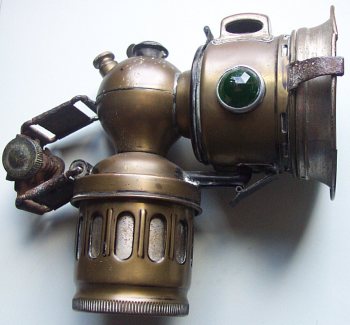 In
those early cycling days (early 1930's), Joan & Les used 'carbide' lamps on
their bikes. In fact, the one pictured here is almost an exact copy of
the ones they used. I bought this lamp with the intention of giving it
to Les to see if he could get it working (he likes tinkering about with
things like that). After talking to various people, particularly my
friend Mauro from Castelfiorentino, who turns out to be a chemist (so he
should know!), I decided I didn't want to be responsible for blowing up a 92 year old especially after he's reached this point in life relatively
unscathed. But of course, once Les had seen it, it was down to the shed and
give it a go. In
those early cycling days (early 1930's), Joan & Les used 'carbide' lamps on
their bikes. In fact, the one pictured here is almost an exact copy of
the ones they used. I bought this lamp with the intention of giving it
to Les to see if he could get it working (he likes tinkering about with
things like that). After talking to various people, particularly my
friend Mauro from Castelfiorentino, who turns out to be a chemist (so he
should know!), I decided I didn't want to be responsible for blowing up a 92 year old especially after he's reached this point in life relatively
unscathed. But of course, once Les had seen it, it was down to the shed and
give it a go.
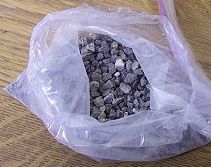 All we needed
now was some calcium carbide! All we needed
now was some calcium carbide!
I was advised to try caving/potholing clubs, but after no luck there, I found a chap in Canada who sold
it by mail order.
Note that it's now no longer available from there, BUT, you can get it from
Caving Supplies in the UK here...
www.caving-supplies.co.uk
By all accounts
these were 'exciting' things to be around! Basically, lumps of carbide were
placed in the bottom chamber. Water was then dripped on to the
carbide from the top chamber and a gas was given off which was lit.
If he ran out of water, Les says he used to ... but we won't go into that here. |
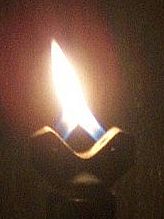 |
The
flame produced is a 'bat wing' flame, the gas arriving from 2 jets. He
reckons the light given off was brilliant white, however, this could be
down to 'rosy memories of how things were in the old days' - I was going
to say a bit like recalling when we had proper cold winters and long hot
summers, but hang on - we used to didn't we! The light weighs a
fair bit (the glass front is incredibly thick!) is very substantially
made, and fastens to the bike on a hinged bracket. Les reckoned
they rocked up and down quite alarmingly, and a trick to stop them going
out when you hit a pothole was to wrap a bit of wire around the ceramic
jets with the end of the wire in the flame. This would glow red
and should the light go out, the gas was immediately re-lit by the heat
of the wire. They weren't daft were they ;-) |
|
Here's a
couple of pictures of the lamp lit. One showing the side view with the
coloured glass inserts, and the other showing Les with a black sooty
smudge on his forehead (but - he's still got his eyebrows :-)
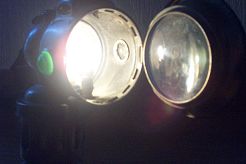 |
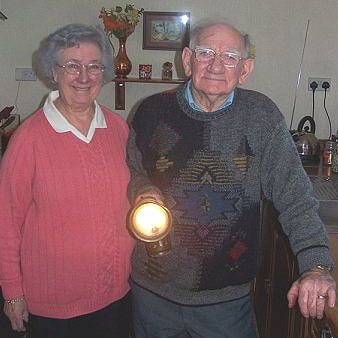 |
The main
problems seemed to be...
 |
Keeping the calcium carbide dry. Les carried
it around in a tin in his saddle bag until it was needed. |
 |
Cleaning the lamp. You had a bit of wire
which you used to clean out the nozzles, though the whole assembly
unhinges and unscrews to make cleaning easier. |
 |
Regulating the 'drip, drip, drip' of water onto the
carbide. |
 |
Disposing of the 'sludge' left over which
I'm reliably informed is garden lime. I guess in the 1930's
it just went down the drain (or on the garden). |
I did ask about the type
of rear light they used, but apparently at the time they were using these
front lamps, they didn't use a rear light at all. They just had a
reflector on the back. It was only when electric light became the norm that
they started using a rear light. Quite a difference from today,
when personally, if anything I'm much more concerned with the quality of my
rear lights (yes, I do use more than one!).
 In
those early cycling days (early 1930's), Joan & Les used 'carbide' lamps on
their bikes. In fact, the one pictured here is almost an exact copy of
the ones they used. I bought this lamp with the intention of giving it
to Les to see if he could get it working (he likes tinkering about with
things like that). After talking to various people, particularly my
friend Mauro from Castelfiorentino, who turns out to be a chemist (so he
should know!), I decided I didn't want to be responsible for blowing up a 92 year old especially after he's reached this point in life relatively
unscathed. But of course, once Les had seen it, it was down to the shed and
give it a go.
In
those early cycling days (early 1930's), Joan & Les used 'carbide' lamps on
their bikes. In fact, the one pictured here is almost an exact copy of
the ones they used. I bought this lamp with the intention of giving it
to Les to see if he could get it working (he likes tinkering about with
things like that). After talking to various people, particularly my
friend Mauro from Castelfiorentino, who turns out to be a chemist (so he
should know!), I decided I didn't want to be responsible for blowing up a 92 year old especially after he's reached this point in life relatively
unscathed. But of course, once Les had seen it, it was down to the shed and
give it a go. 


